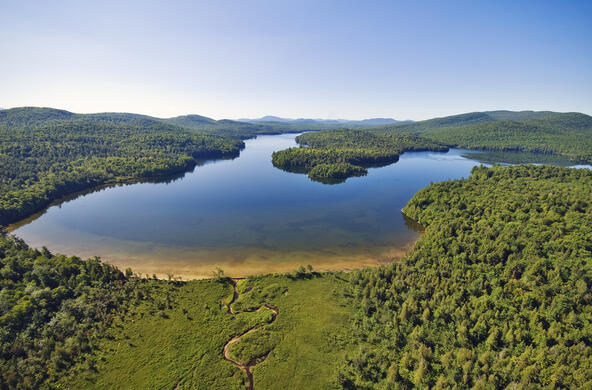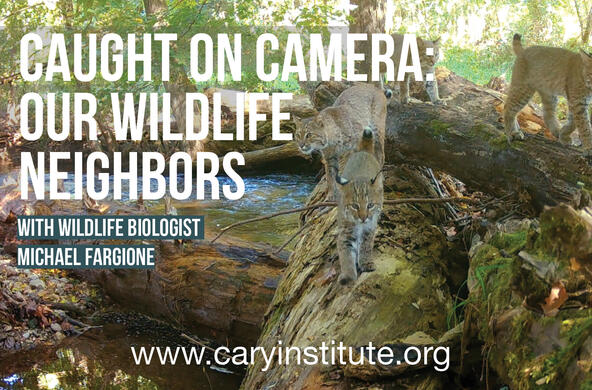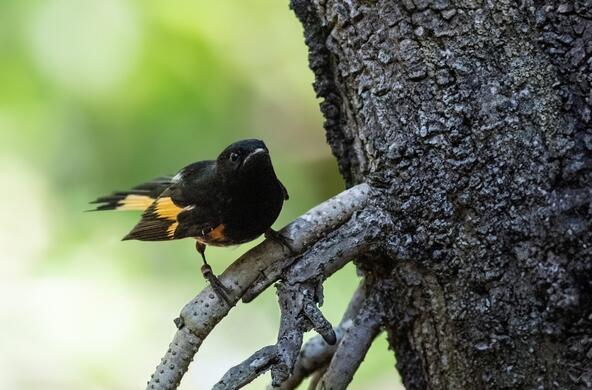As much of the U.S. East Coast continues to dig out from last week's historic blizzard, it's easy to think of snow as a disruptive force that causes normal life to come to a standstill. While that might be true for large cities and the people who live in them, it is not true for wildlife—especially wild animals that have long made their homes in the fields and forests. Those creatures have evolved to live with snow in winter and are adapted to its presence. They have learned to thrive in its depths and use its protective cover for shelter and food.
The problem, scientists tell us, is that climate change is due to bring strange changes to winter all around. Places not expecting any snow may get it in large amounts at surprising times. Meanwhile, places expecting lots of snow may not see any all winter, or may not see it until very late in the season.
Scientists are discovering that this may mean big changes for a lot of creatures—not just the distant polar bears struggling to stay afloat on crumbling ice floes up north, but also for lots of the creatures living in our own backyards. Porcupines, frogs, shrews, voles and even woolly bear caterpillars all may struggle if the snow that they have long lived with all winter begins to change. This is bringing increased attention to the cold season, often overlooked in past in North American field studies.
Lots of people have studied winter ecology in places like the Rockies, Russia, Scandinavia, the Arctic and northern Canada, perhaps because the snow in those regions is so dramatic, deep and visible for such a large part of the year, says Peter Groffman from the City University of New York's Advanced Science Research Center and a fellow at the Cary Institute of Ecosystem Studies.

But few had looked at the winter in much of the rest of North America as anything more than a period of inactivity and dormancy, when snow seemed to be a challenge to birds and mammals that mostly seemed to hibernate, or at least head for cover, as the temperatures dropped and the flakes began to fall.
However, scientists are finding that snow is partly what keeps those animals alive.
"Snow is very important," Groffman says. "It insulates and protects the forest soil. And when you lose that insulation, the soil becomes much more susceptible to freezing. ... If you lose that blanket of snow, you end up with what we call colder soils in a warmer world."
The phrase "blanket of snow" is more than a poetic metaphor—when snow is present, the soil temperatures underneath it stay consistently warmer. Counterintuitively, warmer air temperatures and a lack of snow can actually cause the exposed ground below to become colder. Without the snowpack's protection, exposed soils freeze more readily.
A frozen forest floor spells trouble for animals, even those that hibernate. We often think of a snowy winter landscape as empty and cold and imagine that the majority of animals are sleeping underground, unaware and unaffected by how much snow is above their heads.
But that blanket of snow, ecologists are discovering, often provides a steady, warm temperature range for many animals such as porcupines sleeping away in their dens and birds like the willow ptarmigan, which spend much of the winter on top of the snow but seek cover beneath its blanket during extreme drops in air temperature.
Non-hibernating mammals also depend on the soft, unfrozen ground for survival. Voles and shrews, for instance, tunnel away at the layer of soil just below the snow all winter, foraging for nuts and berries and hidden insects in the unfrozen leaf litter beneath the white drifts.
Among the insect life they might encounter are wooly bear caterpillars. American folklore associates the size of this species' black and brown stripes with the duration of winter weather each year—the legend says that longer stripes in fall foretell a longer winter. But this caterpillar's real link to weather is much more tangible. After producing a special antifreeze-like chemical known as a cryoprotectant, the wooly bears spend the coldest months buried under snow pack in a state of near dormancy, awaiting the arrival of spring.
There's also evidence that a lack of snow pack can cause problems for cold-blooded creatures and insects. Wood frogs, for example, spend winter hibernating deep beneath the snow under leaf litter, where temperatures remain fairly stable. When those same areas dip below freezing, a special adaptation allows the frog's bodies to freeze solid and then thaw repeatedly throughout the coldest months as the mercury dips and rises. But recent research has found that there are metabolic costs to the freeze-thaw pattern that may hinder these animals' ability to emerge and successfully reproduce later in the spring. Too many freeze-thaw cycles, driven by unpredicatable snowpack, may mean fewer wood frogs later.
"Typically the way people have predominantly viewed snow was almost like a simplifying agent of the landscape," says Jonathan Pauli from the University of Wisconsin-Madison. A lot of what was known about winter only really considered what happened to the animals traversing its surface, even among ecologists, he adds.
But back in 2013 he and UW colleague Ben Zuckerberg decided that there was enough evidence about the importance of the natural refuge under snow in the northern U.S. to demand new terminology. Complex relationships were playing out deep out of sight, relationships that needed more study and recognition. Together, the two scientists coined the term "subnivium" to describe what they called the below-the-snow seasonal refuge in places where the ground historically had stayed covered all winter.
They now are working to quantify the subnivium's characteristics across the Great Lakes region of the U.S. to understand how changing snow conditions there might mean changes for the ecosystem in the future.
"The subnivium is kind of a different world [than the surface of the snow] in the sense that it creates a more stable, more hospitable anchor climate for organisms," says Pauli. "They actually get pretty considerable energetic savings from underneath it."
But as is so often the case, it is only now—as the subnivium is becoming less stable and less reliable—that we comprehend the important role is has played all along in our ecosystems.
"The current conditions are going to become more and more novel to a number of species," says Zuckerberg. "So trying to identify the environmental spaces that really are going to serve as refuges for these species in the future is a critical component of conservation right now."






